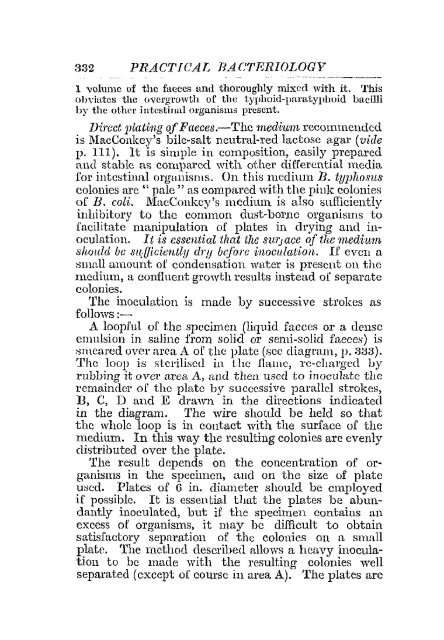AGf~ICULTURAL RESEARCH, PUSA.
AGf~ICULTURAL RESEARCH, PUSA.
AGf~ICULTURAL RESEARCH, PUSA.
Create successful ePaper yourself
Turn your PDF publications into a flip-book with our unique Google optimized e-Paper software.
332 PRACTICAL BACTRRlOLOGY<br />
1 volume of the faeces and thoroughly mixcd with it. 'l'his<br />
o]Jviatcs the overgrowth of the typhoid-paratyphoid bacilli<br />
by the othcr intestinal organisms present.<br />
Direct lJlatil1g of Faeces.-Thc medi'lL11L recommended<br />
is MacConkey's bile-salt neutral-red lactose agar (vide<br />
p. Ill). It is siInple in composition, easily prepared<br />
and stable as eonll)ared with other differential 1l1.edia<br />
for intcstinal organisms. On this medium B. typhosus<br />
colonies are" pale" as compared with the pillk colonies<br />
of B. coli. MacConkcy's medium. is also sufficiently<br />
inhibitory to the common dust-borne organisms to<br />
facilitate manipulation of plates in drying and inoculation.<br />
It -is essenl'ial that the Szt(1 ace of the nwdi'urn<br />
should be :31{[ficiently dry bl/ore tnoculrtlion. If eVCIl n<br />
small amount of condensation water is present on the<br />
medium, a conflucnt growth results instead of separate<br />
colonies.<br />
The inoculation is made by successive strokes as<br />
follows :--<br />
A loopful of the specimen (liquid faeces. or a dense<br />
emulsion in saline from solid or semi-solid faeccs) is<br />
smeared over area A of the plate (see diagram, p. 333).<br />
'The loop is litcl'ilised in the Halllc, l'c-clwl'ged by<br />
rubbing it over gran A, and then used to inoculate the<br />
rcmainder of tho plate by successive parallel strokes,<br />
n, C, D and E drawn in the directions indioated<br />
in the diagram. The wire should be held so that<br />
the wholc loop is in contact with the surface of the<br />
medium. In this way the resulting colonies are evenly<br />
distributed over the plate.<br />
The result depends on the concentration of organisms<br />
in the specimen, and on the size of plate<br />
used. Plates of 6 in. diameter should be cmployed<br />
if possible. It is essential that the plates be abundantly<br />
inoculated, but if the specimen contains an<br />
excess of organisms, it may be difficult to obtain<br />
satisfactory sepamtion of the colonies on a small<br />
plate. 'I'he method described allows a heavy inoculation<br />
to be made with the resulting colonies well<br />
separated (except of COllrse in area A). The plates are

















